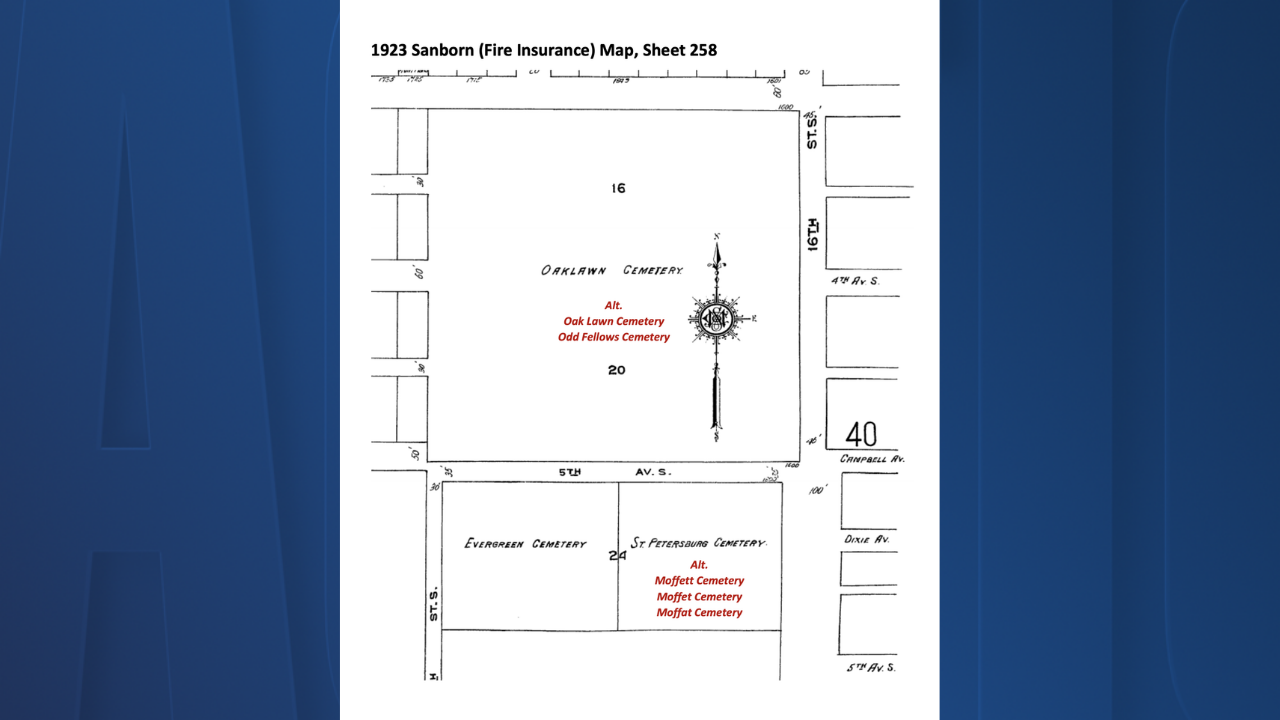ST. PETERSBURG, Fla. — Tropicana Field plays home to the Tampa Bay Rays. The area around the field is the final resting place of hundreds in St. Petersburg.
“I might descend from someone who was buried in this cemetery," Corey Givens, Jr. said.
A resting site is now covered by concrete. The only markings displayed on Lot 1 and Lot 2 are reserved for fans visiting the ballpark.
“It wasn’t just my family that was buried in this cemetery. Hundreds of other folks were buried in these cemeteries.”
Givens, Jr. believes his great-great-grandfather and great-great-aunt are both buried under the I-175 bridge that crosses over 16th Street South in St. Pete.
“Right over here to the left, this is west of the overpass, this is what we believe was Evergreen Cemetery. This was a majority-black cemetery.”
A family bible passed down to him from his grandmother two years ago, shows his ancestors were buried at Evergreen Cemetery, six feet under earth illegally bulldozed more than 70 years ago.
"It was not unusual to build right on top of black cemeteries," Pastor Clarence Williams of Greater Mt. Zion AME Church said.
RECOMMENDED:
- Anthropologists find 45 new unmarked cemeteries and burial grounds in Hillsborough County
- Descendant of African-American woman buried in Zion Cemetery holds memorial
- New task force will record, study and memorialize forgotten Black cemeteries
- Tampa City Council votes unanimously against land-use change for Tampa Heights property
Williams' church sits just four blocks from the erased cemeteries. He has fought for years to right the wrongs made decades ago and give those families some clarity.
“If we have the right support, the documentation, the historical facts of these cemeteries then they really deserve for us to treat them a certain way," Williams said.
Detailed research of the cemeteries, collected and published by the City of St. Petersburg, resurrects the forgotten history.
“It was Oaklawn Cemetery, Evergreen Cemetery, and Moffit Cemetery," Givens, Jr. said.
The known record of the trio dates back to 1888 when Moffett Cemetery, also known as the "Negro Cemetery," was dedicated to soldiers who fought in America's Civil War.

In 1925, an ordinance prohibited further burials at the cemeteries, so the city could extend 5th Avenue South through Evergreen and Moffett. In 1926, an article published in the St. Petersburg Times reports "more than 50 bodies" were moved from Moffett to what is now Lincoln Cemetery in St. Pete, but it is unclear if any were left behind.

“All we want are answers," Givens, Jr. said. "That’s all we want are answers.”
Land developers desecrated unmarked graves at Old Oaklawn Cemetery in 1945 making way for a new apartment complex. An article written at the time says, "gravestones were uprooted and sites obliterated by bulldozers."
“People did what they wanted with those sites," Dr. Antoinette Jackson, an anthropologist at The University of South Florida, said.

Jackson was named to the state-initiated Abandoned African American Cemeteries Task Force, and she helped survey the cemeteries soon after the task force was formed last summer.
“What we’re really talking about is a systemic issue that goes beyond abandoned," Jackson said. "These were deliberately marginalized or erased or in some cases actually stolen or ignored."
In July, penetrating radar detected three graves where Oaklawn Cemetery once was. However, Givens, Jr. is still waiting for a detailed look under the bridge where he believes his ancestors still lie.

“The folks who were disrespected in life and here they are being disrespected in death," he said. "When I come down here and sit in my car I come down here and it’s a somber feeling. I literally just sit here and I soak up the spirit of the ancestors, and it’s almost like they’re talking to me, encouraging me to keep pressing forward and fight on and do the right thing.”
The Florida Department of Transportation owns the land where Evergreen and Moffett Cemeteries once were. St. Petersburg city officials tell ABC Action News they still have not heard from FDOT on plans to examine the area for graves.




